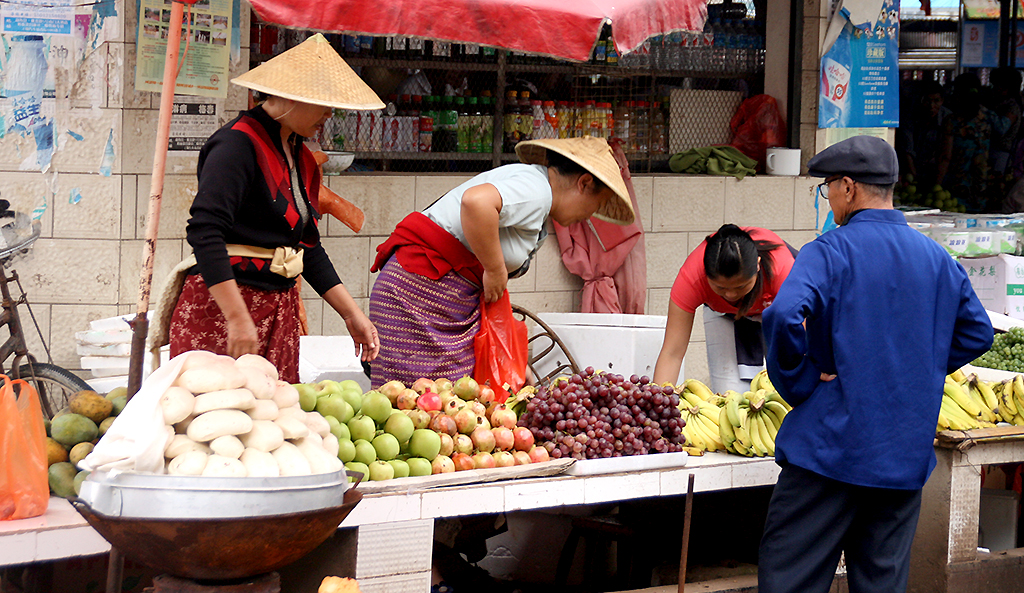Menghai 勐海 xishuangbanna 西双版纳 yunnan Province云南省

Menghai Market Yunnan Province (勐海市场) is a large agricultural produce market in Yunnan’s Xishuangbanna province.
Thwarted by the Monsoon
Our attempts to reach the Sunday market at Menghun 勐混 were thwarted by the monsoon: due to heavy rain the new highway between Jinghong 景洪 and Menghai 勐海 had collapsed and no buses were running that Sunday morning.

When we eventually headed to Menghai 勐海 a few days later the buses were running again, but only on the old road, turning the normally smooth 45- minute journey into a four- hour crawl .

Chaos leaving Jinhong
The most chaotic scenes occurred at the exit of Jinghong, as lorries, buses, tractors and private cars leaving the city fought with those vehicles trying to enter the city to either get on or leave the old road.

The chaos was such that there were kilometres of traffic jams in each direction and not one person of authority was there to put some order to the mayhem.

With so many vehicles stuck with nowhere to go, local entrepreneurs ran between the traffic, selling anything from boiled eggs to grilled meats and soft drinks.

Overturned lorries and their spilt loads only further aggravated an already desperate situation.

Olympic games taking place in Beijing on T.V
In the evening as we settled into our clean but rundown hotel in Menghai we watched the well-organized and meticulously planned Olympic games taking place in Beijing on T.V and wondered if we were really in the same country.

Our first destination from Menghai 勐海 was Gelanghe, a Dai 傣族 and Akha / Yaozu 瑶族 settlement, some 30 kilometres southeast. We took the lazy and wrong option and hired a car and driver for 200 Yuan to take us to Gelanghe.

The road starts climbing into the jungle clad hills only a few kilometres outside Menghai affording stunning views of the valley below.

Stuck in the Mud
Unfortunately due to torrential rains the road had become a quagmire. Our van slid and skidded its way up and up. Twice we had to release it from the mud with stones and planks of wood until the van eventually succumbed to the inevitable and got completely bogged down.

We now became the spectacle. The passing Akha / Yaozu 瑶族, who we had gone to see, stopped to gawp, comment and laugh at our predicament until a tractor, the only type of vehicle able to navigate the road, and its friendly driver pulled us out of the bog and turned our van round.

Defeated we headed back.

Manlei Buddhist Temple at Mengzhe
To compensate for the aborted trip to Gelanghe, we visited the Bajiao Ting (The Octagonal Temple) at Jingzhen 20 kms from Menghai and the Manlei Buddhist Temple at Mengzhe, a few kilometres further along the road.

Although both temples are pleasant, they are reconstructions of originals destroyed during the Cultural Revolution.

The Jingzhen Octagonal Temple Bajiaoting 景真八角亭,had some pleasant Dai style Buddhist murals that depicted gentle rural Scenes.

However, the new paintings at the Manlei Temple, painted by young Dai artists are quite striking and the hell scenes are pretty gruesome.

While the outside of the temple looks rather plain, it’s interior is a riot of colour and the paintings are not for the squeamish.

You can see more of the murals from the Manlei 曼磊佛塔 Temple on our photo video: Buddhist Hell.

Menghai Market Yunnan Province
Don’t miss Menghai’s morning Market just behind the Main road near the post office.

It has a real buzz and you might catch a few Akha, Dai and Lahu dressed in their finest.

Unlike the Menghun market 勐混 市场, the Menghai market 勐海市场 is a market for locals and people from the countryside around. The market gets underway at the crack of dawn and is heaving by 9.00 a.m. By midday it has fizzled out.

The next day we headed out to Xiding Market (See Article).

Menghai 勐海 Coming and Going:

It should be a brisk 45 minute to 1 hour zip along a new highway from Jinghong 景洪 to Menghai 勐海. That is if the monsoon rains haven’t washed the highway away.

Buses run continually throughout the day from both Jinghong’s bus stations. From Menghai’s bus station there are regular buses to Jinghong, Menghun 勐混, for the Sunday market.

There are inconvenient buses for Xiding and its Thursday market (see article). If you are heading to the Burmense border there are buses to Daluo. For the route to Ruili there are plenty of buses to Menglian and Langcang.

This was our plan but the rains made the trip a travel nightmare. Eventually we had to back-tract and head to Menglun and Laos. Outside the wet season this westward journey would make a great trip.

Accomodation:
We stayed at the post office hotel. A clean double cost 80 yuan. Staff were extremely friendly.

Food was a bit limited in Menghai to say the least. Simple restaurants can be found along the main street and some noodle stalls set up at night near the main square.
